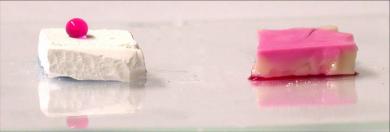Sensing changes: Switching off superhydrophobicity

Superhydrophobicity comes from the amplification of surface chemistry effects by the small-scale roughness of the surface. A surface that is water-fearing becomes super water-fearing when it is made into a foam, but if that water-fearing surface chemistry can be switched off the foam becomes a super-sponge. In these experiments the hydrophobic surface chemistry is switched off by heating the foam above a designed-in trigger temperature. The image on the left shows a droplet of water (with a pink food dye) on a superhydrophobic foam. On the right is the same foam, which looked no different until a droplet of water was deposited and slurped up. The switching can be designed to be triggered by many physical effects and not just heat exposure - the material becomes a simple indicator of the environment.
Read more about these experiments in the publication list below. This effect is described by Nature as a super-sponge with a super-slurp. Click here for more details.
Publications
![]()
Porous materials show superhydrophobic to superhydrophilic switching,
Chem. Comm. 25 (2005) 3135-3137. View postprint pdf
(See also Nature Highlight/News "Quick change for super sponge" Published on-line 20/7/05. Front cover image).
![]()
Super-hydrophobic and super-wetting surfaces: Analytical potential?,
Analyst 129 (4) (2004) 284-287. View postprint pdf
![]()
Superhydrophobic to superhydrophilic transitions of sol-gel films for temperature, alcohol or surfactant measurement,
Maters. Chem. & Phys. 103 (1) (2007) 112-117.

